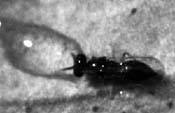Biological Control of Citrus Leafminer Proves to be an IPM Success
By: Dr. L. W. (Pete) Timmer -- Pathologist, CREC
The citrus leafminer (CLM), Phyllocnistis citrella Stainton, has rapidly spread throughout the major citrus-growing areas of the world in recent years. Native to Asia, CLM first spread to Australia and more recently to the Americas and to the Mediterranean area. In rapid succession, CLM appeared in Florida, the Caribbean, Central America, and then in many Mediterranean countries and South America. California is one of the few significant citrus production areas still free of the pest.
CLM arrived in Florida in 1993 with the initial finding in Homestead. Within three months, the insect population had expanded and exploded, covering most of the citrus areas of the state. Repeated applications of many insecticides seemed to have little effect on the population, and growers worried that CLM would devastate citrus groves and nurseries. After a year or two of severe damage, however, the problem has diminished to such an extent that the Florida Citrus Production Research Council has sharply reduced funding for its investigation. It has already been relegated to the category of minor pest. A very similar scenario is being played out in many other citrus areas where CLM was introduced.
Entomologists statewide have developed extensive programs on the basic biology of the insect, as well as on biological and chemical control to combat it. Research has been a cooperative effort among investigators in various centers and departments. The majority of the biological and bio-control studies are being conducted by researchers in the University of Florida's Institute of Food and Agricultural Sciences (UF/IFAS): Marjorie Hoy (IFAS Entomology and Nematology Department, Gainesville), Harold Browning (CREC, Lake Alfred), Phil Stansly and Mark Pomerinke (SWFREC, Immokalee), Jorge Pena (TREC, Homestead), and Bob Bullock (IRREC, Fort Pierce), as well as Ru Nguyen (DPI, Gainesville).
The parasitic wasp, Ageniaspis citricola, was introduced to Florida from Australia, reared in quarantine, and rapidly approved for release. Native parasites and predators were also studied as potential bio-control agents. The introduced parasite was released and now is well established in all major citrus-producing areas of the state.
 This parasite has survived two winters in Florida and is spreading
and increasing in number. Native parasite and predator populations
have also increased and have significantly reduced CLM populations.
In some locations, the introduced bio-control agent represents a
high percentage of the parasitized CLM, and in other instances most
of the CLM are parasitized by native populations.
This parasite has survived two winters in Florida and is spreading
and increasing in number. Native parasite and predator populations
have also increased and have significantly reduced CLM populations.
In some locations, the introduced bio-control agent represents a
high percentage of the parasitized CLM, and in other instances most
of the CLM are parasitized by native populations.
Biological control hasn't been the total answer, however. Chemical control studies have been carried out by Joe Knapp (CREC, Lake Alfred) as well as Pena, Bullock, and Stansly. Severe problems still occur occasionally when parasite and predator populations lag behind the increase in CLM infestations. This frequently occurs in nurseries and young groves where flushes emerge constantly or at times in South Florida where larger numbers of CLM may overwinter.
Many products such as Agrimek, Eclipse, Align, Micromite, and Neemix are now approved for foliar application and, in combination with citrus spray oil, can substantially reduce CLM populations. A systemic insecticide, imidacloprid, has receive emergency clearance for foliar application (Provado) or for soil treatment (Admire).
With effective bio-control agents and specialized products to control outbreaks, CLM no longer represents a disaster for the Florida citrus industry. Maintaining effective levels of bio-control, however, requires avoidance of broad-spectrum insecticides which are toxic to parasites. This factor emphasizes the need for consideration of all pests in decisions concerning pesticides to be applied.
Read more about the citrus leafminer at http://creatures.ifas.ufl.edu/citrus/citrus_leafminer.htm.
Originally published in Florida Grower & Rancher, October, 1996.


